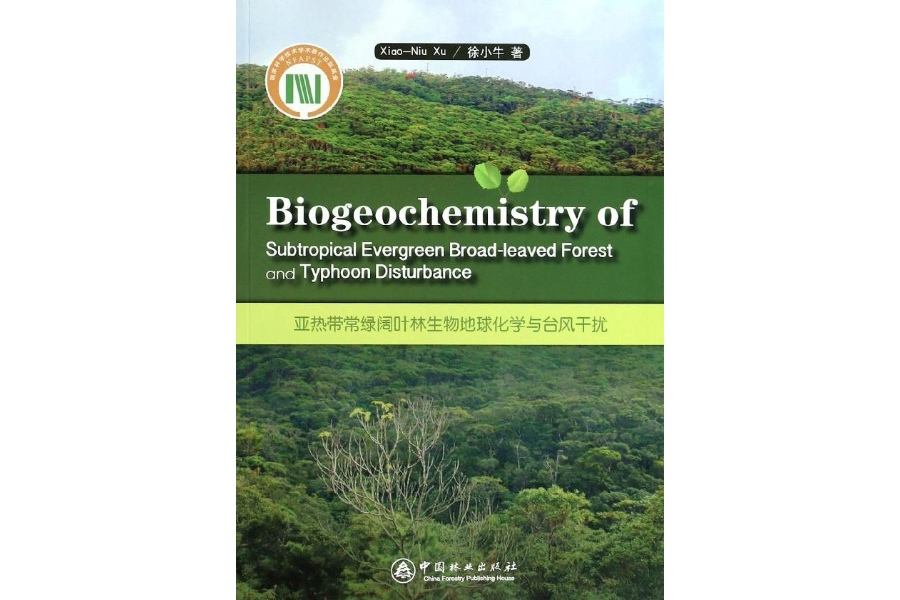《亞熱帶常綠闊葉林生物地球化學與颱風干擾(英文版)》由徐小牛所著,是一項具有明顯創新性的重要研究成果,項目主創人員經過長達十年的定位觀測和機理研究,系統闡明了颱風干擾後亞熱帶常綠闊葉林養分循環的變化特徵及森林可持續經營的措施。
基本介紹
- 中文名:亞熱帶常綠闊葉林生物地球化學與颱風干擾
- 外文名:Biogeochemistry of Subtropical Evergreen Broad-leaved Forest and Typhoon Disturbance
- 作者:徐小牛
- 語言:簡體中文, 英語
- 出版時間:2013年9月1日
- 出版社:中國林業出版社
- 頁數:208 頁
- ISBN:9787503871900
- 類別:圖書>農業/林業>林業
- 開本:16 開
- 裝幀:平裝
內容簡介,圖書目錄,
內容簡介
《亞熱帶常綠闊葉林生物地球化學與颱風干擾(英文版)》可為沿海颱風頻發區森林樹種最佳化配置、林分結構設計以及干擾後森林恢復提供理論依據和有效措施。同時,豐富了生態系統生態學和干擾生態學的研究內容,對推動干擾生態學的研究和發展具有重要的科學意義。
圖書目錄
Preface
1.Introduction
1.1 Characteristics of the Okinawan Evergreen Broad-leaved Forest
and Its Importance for Sustainable Management
1.2 Overview of Nutrient Cycling in Forest Ecosystems
1.3 Effects of Typhoon Disturbances on Forest Ecosystems
1.4 Motives for the Present Synthesis
1.5 The Contents and Organization of the Book
1.6 Summary
2.Study Site Characterization
2.1 Study Area
2.2 Climate
2.3 Topographic Trait and Soils
2.4 Vegetation
3.Soil Properties, Organic Carbon, and Nutrient Pools
3.1 Introduction
3.2 Study Approach
3.2.1 Forest Floor and Mineral Soil Sampling
3.2.2 Experimental Design in the Study
3.2.3 Statistical Analysis and Data Treatment
3.3 Forest Floor Mass and Carbon and Nutrient Pools
3.3.1 Carbon and Nutrient Pools
3.3.2 Topographic Effects
3.4 Soil Properties and Carbon and Nutrient Pools
3.4.1 Soil Properties
3.4.2 Carbon and Nutrient Pools
3.4.3 Cluster Analysis of Soil Data
3.5 Summary
4.Forest Structure, Species Diversity, Regeneration and
Primary production
4.1 Introduction
4.2 Experimental Approach
4.2.1 Field Survey
4.2.2 Species Diversity Indices
4.2.3 Forest Biomass Estimation
4.3 Forest Structure and Floristics
4.3.1 Structural Characteristics
4.3.2 Floristic Composition and Tree Species Diversity
4.3.3 Understory Tree Species Diversity
4.3.4 Controls of Species Diversity
4.3.5 Discussion of Species Diversity
4.4 Forest Regeneration Characteristics
4.4.1 Stand Density
4.4.2 Regeneration Strategies of Canopy Dominants
4.4.3 Restoration of Stand Structure
4.5 Aboveground Biomass and Nutrient Accumulation
4.5.1 Aboveground Biomass
4.5.2 Carbon and Nutrient Storage in Biomass
4.5.3 Discussion on Biomass Estimation and Nutrient Storage
4.6 Summary
5.Organic Matter and Nutrient Dynamics in Litter Production
5.1 Introduction
5.2 Approaches to Forest Litterfall Measurement
5.2.1 Litterfall Measurement
5.2.2 Chemical Analysis
5.2.3 Data Treatment
5.3 Litterfall Production
5.3.1 Amount and Seasonality of Litterfall
5.3.2 Nutrient Inputs by Litterfall
5.4 Effects of Typhoon Disturbance on Litterfall and Related
Nutrient Input
5.5 Discussion
5.5.1 Litter Production
5.5.2 Nutrient Concentration and Inputs
5.5.3 Nutrient Use Efficiency in Litter Production
5.5.4 Effects of Typhoon Disturbances
5.6 Summary
6.Carbon and Nutrient Dynamics in Decomposing Foliar Litter
6.1 Introduction
6.2 Factors Affecting the Decomposition Process
6.2.1 Litter Quality
6.2.2 Climate
6.2.3 Site-specific Variables
6.2.4 Human Activity
6.3 Approaches to the Study of Litter Decomposition
6.3.1 Mass Balance Method
6.3.2 Litterbag Method
6.3.3 Experimental Design in the Study
6.3.4 Chemical Analysis
6.3.5 Data Analysis
6.4 Nutrients Dynamics in Decomposing Foliar Litter
6.4.1 Weight Loss and Decomposition Rate
6.4.2 Initial Foliar Litter Quality
6.4.3 Nutrient Dynamics
6.5 Discussion
6.5.1 Dry Mass Loss and Decomposition Rate
6.5.2 Initial Litter Quality and Nutrient Dynamics
6.6 Summary
7.Nutrient Fluxes in Precipitation, Throughfall, Stemflow and Soil Water
7.1 Introduction
7.2 Methodology of Study of Forest Hydrology
7.2.1 Research Forest Stand
7.2.2 Hydrological Measurements
7.2.3 Chemical Analysis
7.2.4 Data Analysis
7.3 Rainfall Partitioning
7.3.1 Precipitation and Canopy Interception
7.3.2 Surface Runoff and Soil Lateral Flow
7.4 Nutrient Fluxes
7.4.1 Precipitation, Throughfall and Stemflow
7.4.2 Soil Water
7.5 Discussion
7.5.1 Distribution of Rainfall Components
7.5.2 Nutrient Inputs in Precipitation
7.6 Summary
8.Effects of Typhoon Disturbances on Stream Water Chemistry
8.1 Introduction
8.2 Methodology in the Study
8.3 Temporal Patterns of Stream Water Chemistry
8.3.1 Physicochemical Properties of Stream Water
8.3.2 Temporal Patterns of Streamwater Chemistry
8.3.3 Average Streamwater Concentrations During and After Typhoon Season
8.4 Discussion
8.4.1 Controls of Streamwater Chemistry
8.4.2 Effects of Typhoon Disturbance on Streamwater Chemistry
8.5 Summary
9.Integration and Opportunities
9.1 Within Stand Nutrient Cycling, Nutrient Transfer Pathway, and Nutrient Use Efficiency
9.1.1 Nutrient Cycling within the Ecosystem
9.1.2 Nutrient Transfer Pathway
9.1.3 Nutrient Use Efficiency
9.2 Effects of Typhoon Disturbance on Nutrient Cycling
9.3 Control of Forest Structure and Productivity
9.4 Future Opportunities
9.5 Summary
References
Appendix I
Appendix II

